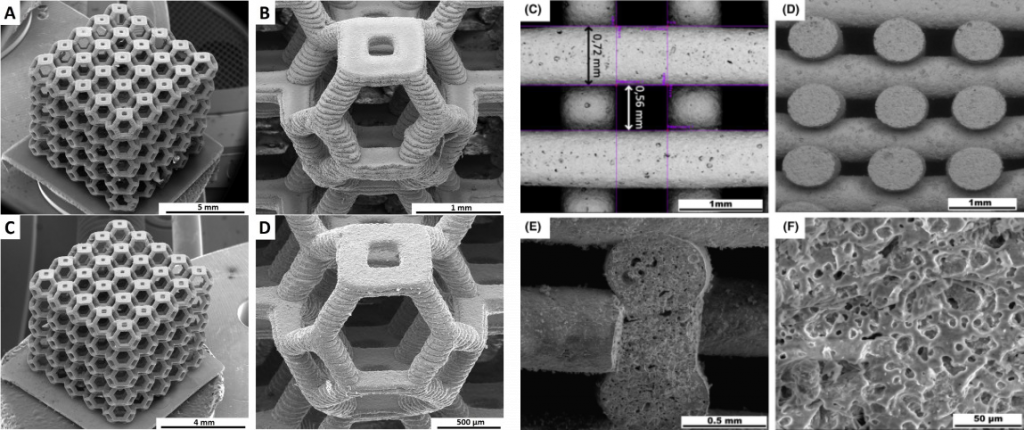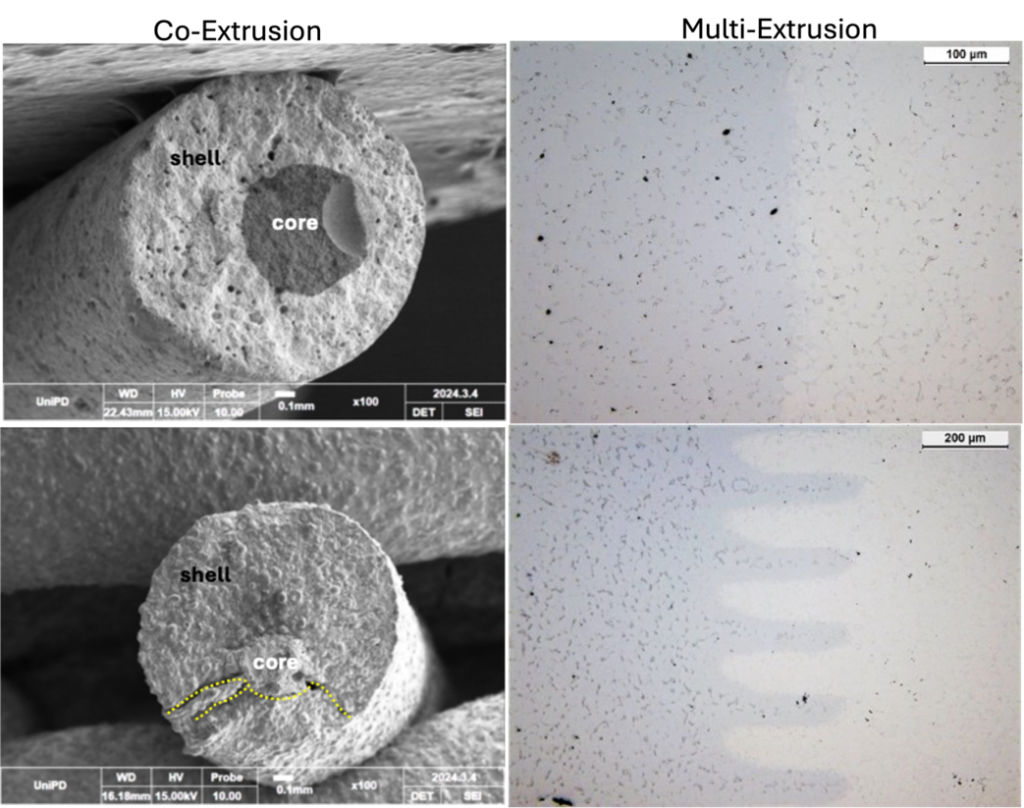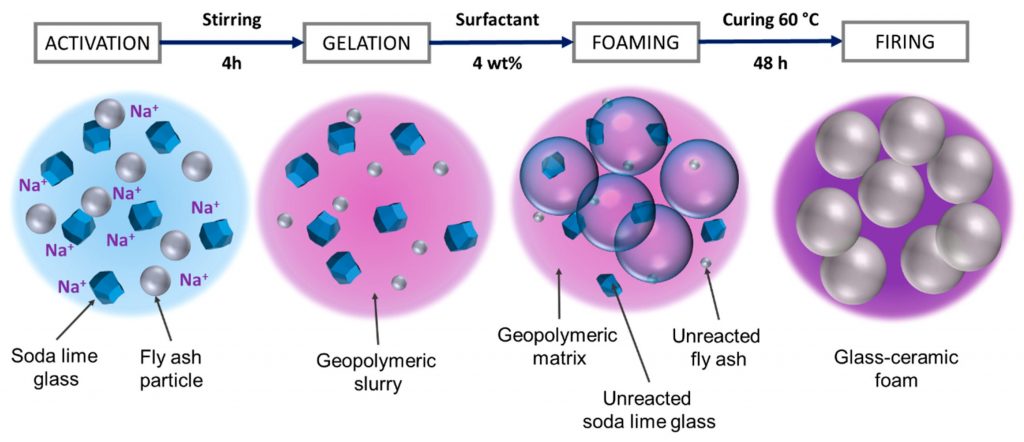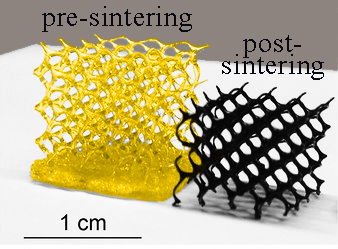The research activities are concentrated in the general area of materials engineering, with a strong focus on advanced and innovative processing approaches and the development of significant engineering characteristics, such as high strength, high porosity and tailored microstructure.
They are carried out in the framework of regional, national and European projects, as well as in collaboration with different national and international industries (check out Partners page for more information).
Additive Manufacturing of ceramics
Additive Manufacturing (AM) technologies have the potential to create new products and business strategies and open new uses and new markets for ceramics. However, ceramic materials are not easy to process by AM, as their requirements (in terms of feedstock and/or sintering) are very challenging; residual pores and cracks are hard to avoid and result in low strength, poor reliability and loss of characteristic material properties (i.e. optical transparency).
CerAMglass group aims to overcome such limitations by developing innovative feedstocks and binders to exploit with multiple AM devices. The focus is particularly on producing cellular components with high complexity and controlled porosity for applications such as filters and catalysts, scaffolds for tissue engineering, electronic devices, lightweight structural parts.
Our fabrication technologies include material extrusion (Direct Ink Writing, DIW; Fused Deposition Modelling, FDM), vat photopolymerization (bottom-up and top-down Digital Light Processing, DLP; Stereolithography, SLA; Two-Photon lithography) and Binder Jetting, and allow us to produce ceramic components across different scales (from hundreds of nm to tens of cm).

Examples of components produced with DLP and DIW technologies
Materials for the environment
Geopolymers are inorganic materials that harden at room temperature forming covalently bonded amorphous networks. They can be used at room temperature or after heat treatment at selected temperatures, and they can withstand temperatures higher than 1000°C, depending on their composition and phase assemblage. Commercial applications include fire- and heat-resistant coatings and matrices for fibre composites (they can withstand temperatures up to 800°C), toxic and radioactive waste encapsulation and greener cement for concrete. Their CO2 emissions during manufacture are much lower than conventional types of cement binders. Moreover, they can be synthesized from recycled raw materials, such as blast furnace slags and fly ashes. Their composition is similar to zeolites, and they also are inherently micro/mesoporous; this makes them very attractive for filtration and catalysis applications. CerAMglass group explores multiple processing approaches for geopolymers: casting and molding of dense parts and composites, foaming and granulation, as well as AM with geopolymeric binders and inks.
Concerning recycled raw materials, CerAMglass group focuses also on glass. The use of scrap glass in manufacturing new glass articles (‘closed-loop recycling’) is possible only after an expensive sorting step, aimed at separating glass from other materials. Huge amounts of soda-lime glass are still unemployed, due to contaminations; in some cases remelting is excluded a priori (e.g. in pharmaceutical glasses, LCD glasses, F-containing opal glasses, etc.) for several requirements (e.g. control of chemical composition, optical quality, fluorine emissions, etc.). CerAMglass group explores the reuse of these glasses as raw materials for new products, such as glass-ceramics and glass foams, with specific attention at the balance between inputs and outputs in energy/emissions. Viscous flow sintering, at moderate temperature (well below 1000 °C) constitutes a key reference, in being feasible for glass alone as well as for several glass/inorganic waste mixtures and in yielding new building materials (replacing natural stones and polymeric thermal and acoustic insulators), often offering extra functionalities (e.g. electromagnetic shielding). Sintered glass-based products thus offer an alternative to geopolymers for waste encapsulation. Finally, the sintering approach may be applied, with the same target applications, to waste-derived glasses, i.e. from glasses developed by melting (at CerAMglass or at partner institutions) mixtures of inorganic wastes.
Processing scheme for the production of glass-ceramic foams
Preceramic polymers
Preceramic polymers are inorganic polymers, typically containing Si atoms in the backbone, that can be converted into ceramics with a high yield, via high-temperature treatment in inert or oxidative atmospheres or by ion irradiation (for coatings). The most frequently used preceramic polymers are polysiloxanes, polysilazanes, and polycarbosilanes, yielding SiOC, SiCN, or SiC ceramics after pyrolysis, but aluminium- and boron-containing polymers are also possible. The polymer-to-ceramic conversion occurs with gas release and shrinkage in the 400°C–800°C temperature range. Also, various fillers (either reactive or inert) can be mixed with preceramic polymers to produce numerous advanced ceramic phases. Polymer-derived ceramics (PDCs) possess useful properties, such as high microstructural stability, high creep resistance, high viscosity, high modulus, high hardness, high wear resistance, high oxidation resistance, high refractoriness, high chemical durability, electronic conduction (SiCN- or C clusters), luminescence (C, Si, SiC nano-clusters).
Preceramic polymers are particularly attracting as they can be shaped using a wide range of plastic-forming technologies.
CerAMglass group has worked extensively, in the past, on the investigation of innovative processing ways for the fabrication of unique components, including electrospinning, micro-fluidics, emulsions, warm pressing, coating, ion irradiation and foaming. Recently, our focus has been on Additive Manufacturing, and we fabricated samples using Binder Jetting (in collaboration with BAM, Berlin), Digital Light Processing, Direct Ink Writing and Two-photon lithography. We are working both on C-containing PDCs (pyrolysis in an inert atmosphere) and oxide PDCs (heating in air).
Biomaterials
CerAMglass group explores the application of preceramic polymers in silicate biomaterials. Silicones filled with oxide fillers, when fired in air, generally offer the possibility to develop crystalline silicate or alumino-silicate ceramics of wide engineering interest (mullite, zircon, cordierite, gehlenite etc.) in conditions of high phase purity and low processing temperature. This fact is exploited mainly for Ca-based silicates (wollastonite, diopside, akermanite, hardystonite and related solid solutions), in the form of highly porous foams and scaffolds, to be used for bone tissue applications. Semi-crystalline materials, i.e. glass-ceramics, are also feasible, mainly using hydrated borates and phosphates as minor fillers. Silicone-based mixtures are particularly interesting for the application of additive manufacturing technologies, such as direct ink writing or stereolithography. These technologies are extended also to bioglass powders, subjected to conventional viscous flow sintering (often with concurrent crystallization).

Examples of biomaterials: on the left, Diopside-Wallostonite components (as printed (A, B) and sintered at 1100 °C (C, D)),
on the right, microstructural details of Biosilicate® 3D printed scaffolds
Multi-materials Additive Manufacturing
Multi-material 3D printing represents a new challenge for additive manufacturing (AM) technologies and paves the way for a new generation of composite materials. AM technologies potentially allow for the deposition of materials with specific properties only where they are required, thus reducing raw material consumption and improving the efficiency of components in service. When both ceramics and metals are involved, challenges arise such as controlling interface bonding, sintering temperatures, residual porosity, etc.
The CerAMglass group is focused on developing new multi-material 3D printing strategies based on the Materials Extrusion (MEX) process. Both co-extrusion and multi-extrusion technologies are being investigated with a circular thinking approach, starting from pellet or paste formulations, design optimization, g-code generation, de-binding, and sintering. A Finite Element Modeling approach (in collaboration with POLIMI and LNL-INFN) is used to predict the effect of specific physical parameters on the final thermo-mechanical properties of the bi-material.

Examples of success and failure stories of materials co-extrusion (left) Bi-material extrusion at the interface (right)
–
Take a look at the Publications page for further details on our research work.


